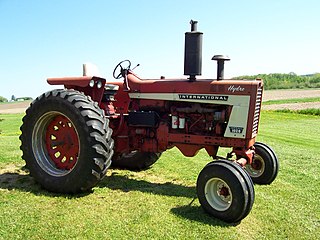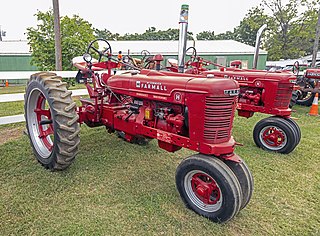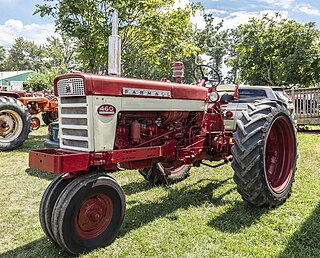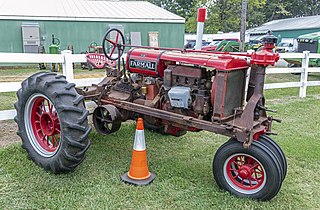Cub Cadet is an American company that produces outdoor power equipment and services, including utility vehicles, handheld and chore products as well as snow throwers.

The International Harvester Company was an American manufacturer of agricultural and construction equipment, automobiles, commercial trucks, lawn and garden products, household equipment, and more. It was formed from the 1902 merger of McCormick Harvesting Machine Company and Deering Harvester Company and three smaller manufactures: Milwaukee; Plano; and Warder, Bushnell, and Glessner. In the 1980s all divisions were sold off except for International Trucks, which changed its parent company name to Navistar International. Its brands included McCormick, Deering, and later McCormick-Deering, as well as International. Along with the Farmall and Cub Cadet tractors, International was also known for the Scout and Travelall vehicle nameplates.

Farmall was a model name and later a brand name for tractors manufactured by International Harvester (IH), an American truck, tractor, and construction equipment company. The Farmall name was usually presented as McCormick-Deering Farmall and later McCormick Farmall in the evolving brand architecture of IH.

The Farmall Cub or International Cub was the smallest tractor manufactured by International Harvester (IH) under either the McCormick-Deering, Farmall, or International names from 1947 through 1979 in Louisville, Kentucky.

The Farmall 1026 is a row crop tractor with a hydraulic drive system, or hydro, produced by International Harvester from 1970–1971. Rated at 112 power take off, (PTO) horsepower, the Farmall 1026 was the first 100+ horsepower hydro tractor ever produced.

The Farmall H is a medium-sized two-plow row crop tractor produced by International Harvester under the Farmall brand from 1939 to 1954. It was the most widely produced of International Harvester's "letter series", with approximately 390,000 produced over the 14-year run. It succeeded the Farmall F-20. The H was incrementally updated with new model numbers as the Super H, 300, and 350, but remained essentially the same machine. The original H used an International Harvester C152 4-cylinder in-line engine. Production of all versions lasted until 1963.

The Farmall M is a large three-plow row crop tractor produced by International Harvester under the Farmall brand from 1939 to 1953. It was of International Harvester's "letter series". It succeeded the Farmall F-30. The M was incrementally updated with new model numbers as the Super M, Super M-TA, 400, and 450, but remained essentially the same machine. The original M used an International Harvester C248 4-cylinder in-line engine. Production of all versions lasted until 1954.

The Farmall C is a small two-plow row crop tractor produced by International Harvester under the Farmall brand from 1948 to 1951. The C was developed from the Farmall B as a slightly larger, more versatile implement, raising and moving the B's offset operator seat to the centerline and increasing the wheel size to allow a straight, widely-adjustable rear axle. The C kept the International Harvester C123 engine that had been used in the Super B model. The tractor was heavier and more robust, and featured hydraulic capability from the beginning. The C was incrementally updated with new model numbers as the Super C, 200, 230 and 240, but remained essentially the same machine. The closely-related successors to the C were produced until 1962.

The Farmall A is a small one-plow row crop tractor produced by International Harvester under the Farmall brand from 1939 to 1947. The tractor was popular for its set of innovative features in a small, affordable implement. It succeeded the Farmall F-14. The A was incrementally updated with new model numbers as the Super A, 100, 130 and 140, but remained essentially the same machine. Like the smaller Farmall Cub, the Farmall A features a distinctive offset engine, displaced to the left over wide-set front wheels, to allow vision straight ahead. An International Harvester C113 4-cylinder in-line engine was used for early models, increased to an IH C123 with the A-1. The most significant change was the introduction of hydraulics with the Super A. The series was produced until 1973.

The Farmall 60 series tractors are general-purpose row-crop tractors that replaced the larger models of the Farmall letter series beginning in 1958. Produced from 1958 to 1963, the Farmall 460 and 560 tractors represented a modernization of the Farmall H and Farmall M respectively, with higher-horsepower 6-cylinder engines in a restyled body. The heavy general-purpose 660 was sold under the International brand, and was a successor to the McCormick-Deering W series tractors.

The McCormick-Deering W series tractors were a range of standard-tread farming and industrial tractors produced by International Harvester that were derived from the Farmall letter series row-crop tractors of the 1940s and 1950s. Branded by International Harvester as McCormick-Deering products, with the same styling and red paint as the Farmall line, the W series had fixed wheel widths, lower height and wide front axles. Starting in 1956 the W series was integrated into the International Harvester numbering series and the McCormick-Deering branding was dropped.

The Farmall F-20 is a medium-sized two-plow row crop tractor produced by International Harvester under the Farmall brand from 1932 to 1939, with approximately 148,000 produced. It replaced the Farmall Regular, and was itself replaced in 1939 by the Farmall H.

The Farmall F-12 is a small two-plow row crop tractor produced by International Harvester under the Farmall brand from 1932 to 1938, with approximately 123,000 produced. An improved model, the two-plow F-14, was produced beginning in 1938 and ending in 1939, when the Farmall letter series tractors were introduced.
The Farmall 340 is a medium-sized row-crop tractor, first produced as part of the Farmall line by International Harvester in 1957. The 340 was a completely new design, unrelated to its predecessor the Farmall 350. Production ran until 1963 for the Farmall model, while production under the International and International Harvester name ran until 1965.
The Farmall 04 series tractors are a family of row-crop tractors with four-cylinder engines, continuing the tradition of four-cylinder engines in Farmall and parent company International Harvester for general-purpose and row-crop tractors. In the early 1960s demand for more power led to the 06 series with six-cylinder engines. Four-cylinder engines were reserved for tractors equivalent to the Farmall H and smaller.

The Farmall 06 series tractors are a family of row-crop tractors with six-cylinder engines, providing greater horsepower than the parallel product line of four-cylinder Farmall 04 series tractors. Until the late 1950s, Farmall and parent company International Harvester tractors used four-cylinder engines for general-purpose and row-crop tractors. Demands for higher performance and greater horsepower led to broader use of six-cylinder engines, with the bulk of International's production moving to the larger engines. The Farmall 806 and 706 were introduced in 1963, with production running to 1976 and 1967 respectively.. The Farmall 1206 was introduced in 1965 as the most powerful tractor of its time, using a turbocharged diesel engine. Production of the 1206 ran until 1967. The 06 series sold well and was regarded as extremely successful.
International Harvester produced farm tractors in Australia under both the Farmall and McCormick International brands from 1939 until 1973, after which only the McCormick International brand was used. As in the North American market, the Farmall brand was reserved primarily for row-crop tractors with narrow front wheels. Farmall tractors were sold alongside wide-front McCormick International-badged tractors of the same series. Initial production was mainly from imported parts. The first fully-Australian-made tractors were not built at the Geelong works until 1948.

International Harvester's Farmall brand of tractors were built in the United Kingdom between 1949 and 1970. The Farmall name was applied sparingly to International Harvester's UK products, appearing only as the BM, BMD and B-450.

International Harvester's Farmall brand of tractors was built in Germany between 1937 and 1959. For most of this time, the Farmall brand was not prominently used, even though the equipment was based on and styled similarly to the Farmall line. The D-217 Farmall was the product that most prominently displayed the brand. As IH Germany's product line increasingly diverged from that of the parent company, other brands were adopted, and most products were marketed as International.















